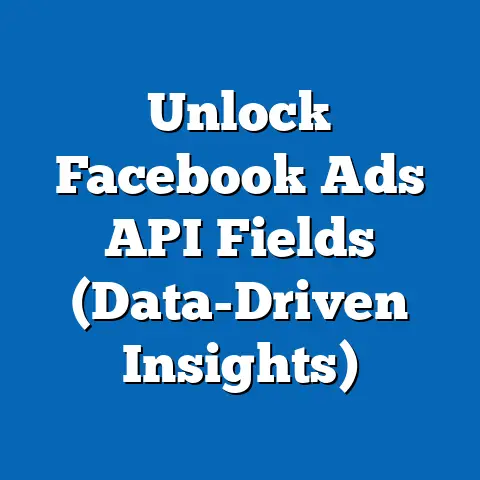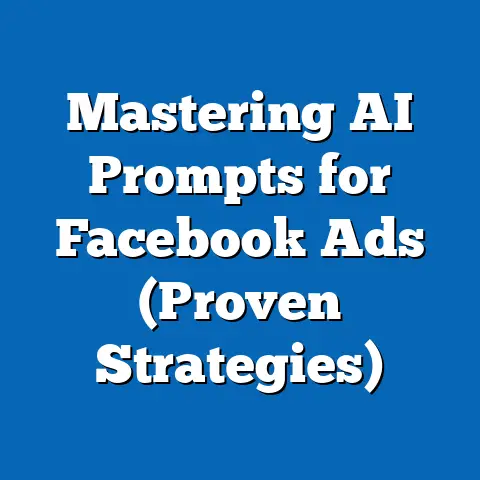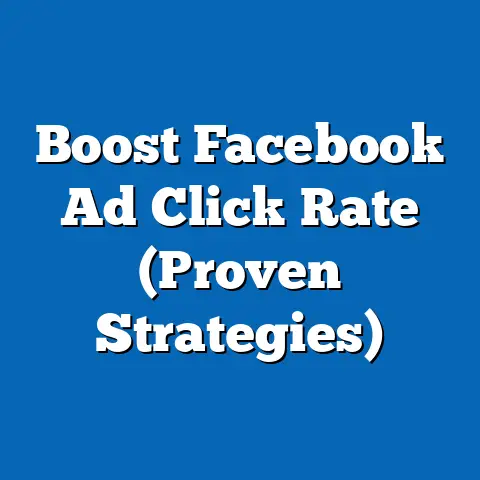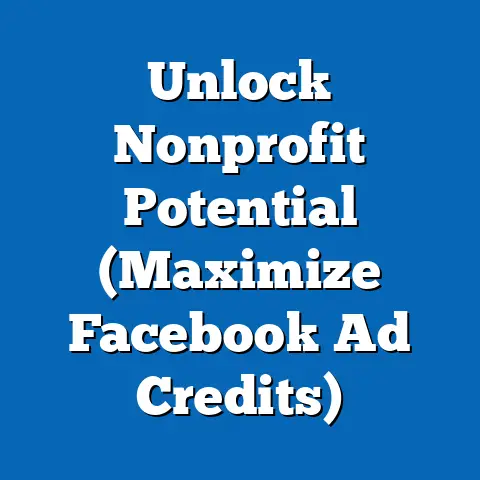Unlock Facebook Ads Payments (Revenue Insights Revealed)
Have you ever wondered why some businesses thrive on Facebook while others struggle to see a return on their ad spend? It’s a question I’ve pondered myself countless times, especially when I was first starting out in the world of digital marketing. I remember pouring hours into crafting what I thought were brilliant ads, only to be met with disappointing results. The key, as I learned, lies in understanding the intricacies of Facebook Ads payments and leveraging revenue insights to optimize your campaigns.
Introduction
In today’s digital age, Facebook advertising has become an indispensable tool for businesses of all sizes. With billions of active users, Facebook provides an unparalleled platform to reach target audiences, drive brand awareness, and ultimately, generate revenue. However, simply throwing money at Facebook Ads isn’t enough. To truly unlock the revenue-generating potential of Facebook, you need to understand the underlying payment structures, analyze key performance metrics, and implement strategic optimization techniques.
In this article, I’ll take you on a journey through the world of Facebook Ads payments, revealing the secrets to maximizing your return on ad spend. We’ll explore the mechanics of the Facebook Ads auction system, dissect the metrics that matter most, and uncover proven strategies for optimizing your campaigns. We’ll also delve into common pitfalls to avoid and explore emerging trends that could shape the future of Facebook advertising. So, buckle up and get ready to unlock the full potential of Facebook Ads for your business.
Section 1: Understanding Facebook Ads Payments
The first step in mastering Facebook Ads is understanding how the payment system works. It’s not just about setting a budget; it’s about understanding the underlying mechanics that determine how your money is spent.
How Facebook Ads Work: The Auction System
Facebook Ads operate on an auction system. This means that every time a Facebook user is eligible to see an ad, Facebook runs an auction to determine which ad will be shown. Several factors influence the outcome of this auction, including:
- Your Bid: This is the amount you’re willing to pay for a specific outcome, such as a click, an impression, or a conversion.
- Ad Quality and Relevance: Facebook assesses the quality and relevance of your ad based on factors like user engagement (likes, shares, comments) and feedback.
- Estimated Action Rate: Facebook predicts how likely users are to take the desired action (e.g., clicking on your ad, visiting your website).
The ad with the highest overall value, determined by these factors, wins the auction and is displayed to the user. This means that even if you have a lower bid than another advertiser, your ad can still win if it’s deemed more relevant and engaging.
Key Terms: CPC, CPM, and ROAS
Understanding key advertising terms is crucial for interpreting your campaign performance and making informed decisions about your ad spend. Here are three of the most important metrics:
- Cost Per Click (CPC): This is the amount you pay each time someone clicks on your ad. CPC is a good indicator of how engaging your ad is and how well it resonates with your target audience. A lower CPC generally indicates a more effective ad.
- Cost Per Impression (CPM): This is the amount you pay for every 1,000 impressions (the number of times your ad is displayed). CPM is useful for assessing the cost of reaching a large audience, regardless of whether they click on your ad.
- Return on Ad Spend (ROAS): This is the most important metric for measuring the overall profitability of your Facebook Ads campaigns. ROAS is calculated by dividing the revenue generated by your ads by the amount you spent on those ads. For example, a ROAS of 3 means that for every dollar you spent on ads, you generated three dollars in revenue.
Payment Options and Their Influence
Facebook offers various payment options, each with its own advantages and disadvantages. The most common options include:
- Automatic Payments: Facebook automatically charges your credit card or PayPal account when you reach a certain spending threshold or at the end of your billing cycle. This is the most convenient option for most advertisers.
- Manual Payments: You manually add funds to your Facebook Ads account before your ads run. This option gives you more control over your spending but requires more active management.
The payment option you choose can indirectly influence your campaign performance. For example, with automatic payments, you don’t have to worry about your ads being paused due to insufficient funds. With manual payments, you might be more cautious about your spending, which could lead to more strategic bidding.
Takeaway: Understanding the Facebook Ads auction system, key metrics like CPC, CPM, and ROAS, and the available payment options is the foundation for successful Facebook advertising.
Section 2: Analyzing Revenue Insights
Now that you understand the basics of Facebook Ads payments, let’s dive into how to analyze revenue insights to measure the effectiveness of your campaigns. This is where data becomes your best friend.
Metrics That Matter: Beyond Clicks and Impressions
While clicks and impressions are important, they don’t tell the whole story. To truly understand the revenue impact of your Facebook Ads, you need to focus on metrics that directly correlate with sales and conversions. These include:
- Conversion Rate: This is the percentage of people who click on your ad and then complete a desired action, such as making a purchase or filling out a form.
- Cost Per Acquisition (CPA): This is the amount you pay for each conversion. CPA is a crucial metric for determining the profitability of your campaigns.
- Customer Lifetime Value (CLTV): This is the total revenue you expect to generate from a customer over the course of their relationship with your business. CLTV helps you determine how much you can afford to spend to acquire a new customer.
- Attribution: Understanding which ads and campaigns are contributing to your overall revenue is vital. Facebook’s attribution models can help you track the customer journey and give credit where it’s due.
Tools of the Trade: Facebook Ads Manager and Facebook Analytics
Facebook provides two powerful tools for tracking and analyzing your campaign performance:
- Facebook Ads Manager: This is your central hub for creating, managing, and analyzing your Facebook Ads campaigns. Ads Manager provides a wealth of data on your ad performance, including impressions, clicks, conversions, and ROAS.
- Facebook Analytics: This tool allows you to track user behavior on your website and app, providing valuable insights into how people interact with your business after clicking on your ads.
By combining data from Ads Manager and Analytics, you can gain a holistic view of your Facebook Ads performance and identify areas for improvement.
The Power of Conversion Tracking
Conversion tracking is essential for understanding the true impact of your Facebook Ads on your bottom line. By setting up conversion tracking, you can track specific actions that users take on your website or app after clicking on your ad, such as making a purchase, filling out a form, or subscribing to a newsletter.
Facebook offers several options for conversion tracking, including:
- Facebook Pixel: This is a snippet of code that you install on your website to track user actions.
- Conversion API: This allows you to send conversion data directly from your server to Facebook, providing more accurate and reliable tracking.
By implementing conversion tracking, you can see exactly which ads and campaigns are driving the most valuable actions for your business.
Real-World Examples: Data-Driven Success
I once worked with a small e-commerce business that was struggling to generate sales through Facebook Ads. They were running ads with generic messaging and broad targeting, and their ROAS was abysmal.
By implementing conversion tracking and analyzing their data, we discovered that a significant portion of their sales were coming from a specific segment of their audience who were interested in a particular product category. We then created targeted ads with tailored messaging for this audience, and their ROAS skyrocketed.
This example highlights the importance of data-driven decision-making in Facebook advertising. By tracking your results and analyzing your data, you can identify what’s working and what’s not, and make adjustments to your campaigns accordingly.
Takeaway: Analyzing revenue insights is crucial for understanding the true impact of your Facebook Ads. Focus on metrics that correlate with sales and conversions, utilize Facebook Ads Manager and Analytics, and implement conversion tracking to gain a holistic view of your campaign performance.
Section 3: Strategies for Optimizing Ad Spend
Once you have a solid understanding of Facebook Ads payments and revenue insights, you can start implementing strategies to optimize your ad spend and maximize your return on investment.
Audience Targeting: Finding Your Ideal Customer
Targeting the right audience is essential for the success of any Facebook Ads campaign. Facebook offers a wide range of targeting options, allowing you to reach specific demographics, interests, behaviors, and connections.
Here are some key audience targeting tips:
- Utilize Custom Audiences: Create custom audiences based on your existing customer data, such as email lists, website visitors, and app users. This allows you to target people who are already familiar with your brand.
- Leverage Lookalike Audiences: Expand your reach by creating lookalike audiences based on your custom audiences. Facebook will identify people who share similar characteristics with your existing customers.
- Experiment with Interest-Based Targeting: Target people based on their interests, hobbies, and activities. Use Facebook’s Audience Insights tool to discover relevant interests for your target audience.
- Refine Your Targeting: Continuously monitor your campaign performance and refine your targeting based on the data. Exclude audiences that are not performing well and focus on those that are driving the most conversions.
Creative Best Practices: Capturing Attention
Your ad creative is what grabs people’s attention and compels them to take action. To create compelling ads, follow these best practices:
- Craft Compelling Ad Copy: Use clear, concise, and persuasive language that highlights the benefits of your product or service.
- Use High-Quality Visuals: Choose images and videos that are visually appealing and relevant to your target audience.
- Include a Clear Call to Action: Tell people exactly what you want them to do, such as “Shop Now,” “Learn More,” or “Sign Up.”
- Test Different Ad Formats: Experiment with different ad formats, such as image ads, video ads, carousel ads, and collection ads, to see what performs best for your business.
Timing and Scheduling: Reaching People at the Right Time
The timing and scheduling of your ads can significantly impact their performance. Consider the following factors when determining when to run your ads:
- Your Target Audience’s Behavior: Analyze your website and social media data to determine when your target audience is most active online.
- Time Zones: If you’re targeting a global audience, consider the different time zones and schedule your ads accordingly.
- Day of the Week: Experiment with running your ads on different days of the week to see what performs best.
- Special Events and Holidays: Capitalize on special events and holidays by running targeted ads with relevant messaging.
The Power of A/B Testing
A/B testing, also known as split testing, is the process of comparing two versions of an ad to see which one performs better. A/B testing is essential for optimizing your Facebook Ads campaigns and maximizing your return on investment.
You can A/B test various elements of your ads, including:
- Headlines: Test different headlines to see which ones grab the most attention.
- Images: Test different images to see which ones resonate best with your target audience.
- Call to Actions: Test different call to actions to see which ones drive the most conversions.
- Targeting Options: Test different targeting options to see which ones reach the most qualified audience.
By continuously A/B testing your ads, you can identify what’s working and what’s not, and make data-driven decisions to improve your campaign performance.
Case Studies: Successful Optimization Strategies
I worked with a local restaurant that wanted to increase reservations through Facebook Ads. They were running ads with generic messaging and targeting a broad audience.
By implementing A/B testing, we discovered that ads with photos of their most popular dishes performed significantly better than ads with generic stock photos. We also found that targeting people who were interested in specific types of cuisine (e.g., Italian, Mexican) drove more reservations than targeting a broad audience.
By implementing these optimization strategies, the restaurant was able to increase their reservations by 50% and significantly improve their ROAS.
Takeaway: Optimizing your ad spend requires a strategic approach that encompasses audience targeting, creative best practices, timing and scheduling, and A/B testing. By continuously monitoring your campaign performance and making data-driven adjustments, you can maximize your return on investment.
Section 4: Common Pitfalls and How to Avoid Them
Even with a solid understanding of Facebook Ads payments, revenue insights, and optimization strategies, it’s easy to fall into common pitfalls that can hinder your success. Here are some common mistakes to avoid:
- Ignoring Mobile Optimization: With the majority of Facebook users accessing the platform on mobile devices, it’s crucial to optimize your ads for mobile viewing. Make sure your ads are visually appealing on smaller screens and that your landing pages are mobile-friendly.
- Lack of a Strong Landing Page: Your landing page is where people end up after clicking on your ad. If your landing page is poorly designed, confusing, or irrelevant to your ad, you’ll lose potential customers. Make sure your landing page is clear, concise, and focused on driving conversions.
- Setting Unclear Objectives and KPIs: Before launching a Facebook Ads campaign, it’s essential to define your objectives and key performance indicators (KPIs). What do you want to achieve with your ads? What metrics will you use to measure success? Without clear objectives and KPIs, it’s difficult to track your progress and make informed decisions.
- Ignoring Ad Fatigue: Over time, your target audience may become tired of seeing the same ads. This is known as ad fatigue. To combat ad fatigue, rotate your ad creative regularly and experiment with different messaging and targeting options.
- Failing to Monitor and Adjust: Facebook Ads is not a “set it and forget it” platform. To achieve optimal results, you need to continuously monitor your campaign performance and make adjustments as needed. Pay attention to your metrics, analyze your data, and be willing to adapt your strategies based on what’s working and what’s not.
Takeaway: Avoiding common pitfalls is just as important as implementing optimization strategies. Pay attention to mobile optimization, create strong landing pages, set clear objectives and KPIs, combat ad fatigue, and continuously monitor and adjust your campaigns.
Section 5: Future Trends in Facebook Advertising
The world of Facebook advertising is constantly evolving. To stay ahead of the curve, it’s essential to be aware of emerging trends that could impact your campaigns.
- The Rise of AI and Machine Learning: Facebook is increasingly leveraging AI and machine learning to improve ad targeting and personalization. Expect to see more AI-powered features that automate tasks, optimize bids, and personalize ad experiences.
- The Growth of Social Commerce: Social commerce, the practice of selling products directly on social media platforms, is on the rise. Facebook is investing heavily in social commerce features, such as Shops and product tagging, making it easier for businesses to sell their products directly to consumers on the platform.
- The Metaverse and Virtual Reality: As the metaverse and virtual reality technologies become more mainstream, expect to see new advertising opportunities emerge on these platforms. Facebook (Meta) is at the forefront of this trend, and it’s likely that we’ll see new ad formats and targeting options specifically designed for the metaverse in the future.
- Increased Focus on Privacy: With growing concerns about data privacy, Facebook is under pressure to provide users with more control over their data. Expect to see more privacy-focused features and policies that could impact ad targeting and data collection.
Takeaway: Staying informed about future trends is crucial for long-term success in Facebook advertising. Keep an eye on the rise of AI and machine learning, the growth of social commerce, the metaverse, and the increasing focus on privacy.
Conclusion
Unlocking the full potential of Facebook Ads payments and revenue insights is crucial for businesses looking to thrive in the digital marketplace. By understanding the mechanics of the Facebook Ads auction system, analyzing key performance metrics, implementing strategic optimization techniques, avoiding common pitfalls, and staying informed about emerging trends, you can maximize your return on ad spend and drive significant revenue growth.
I’ve shared with you the knowledge and tools you need to succeed on Facebook. Now it’s up to you to put these strategies into action. Start by implementing conversion tracking, analyzing your data, and A/B testing your ads. Continuously monitor your campaign performance and make data-driven adjustments. Don’t be afraid to experiment and try new things.
The world of Facebook advertising is constantly evolving, but by staying informed, adaptable, and data-driven, you can unlock the full potential of Facebook Ads for your business.
Now, go forth and conquer the world of Facebook Ads! I’m confident that with the knowledge and strategies I’ve shared, you’ll be well on your way to achieving your advertising goals and driving significant revenue growth for your business. Good luck!






